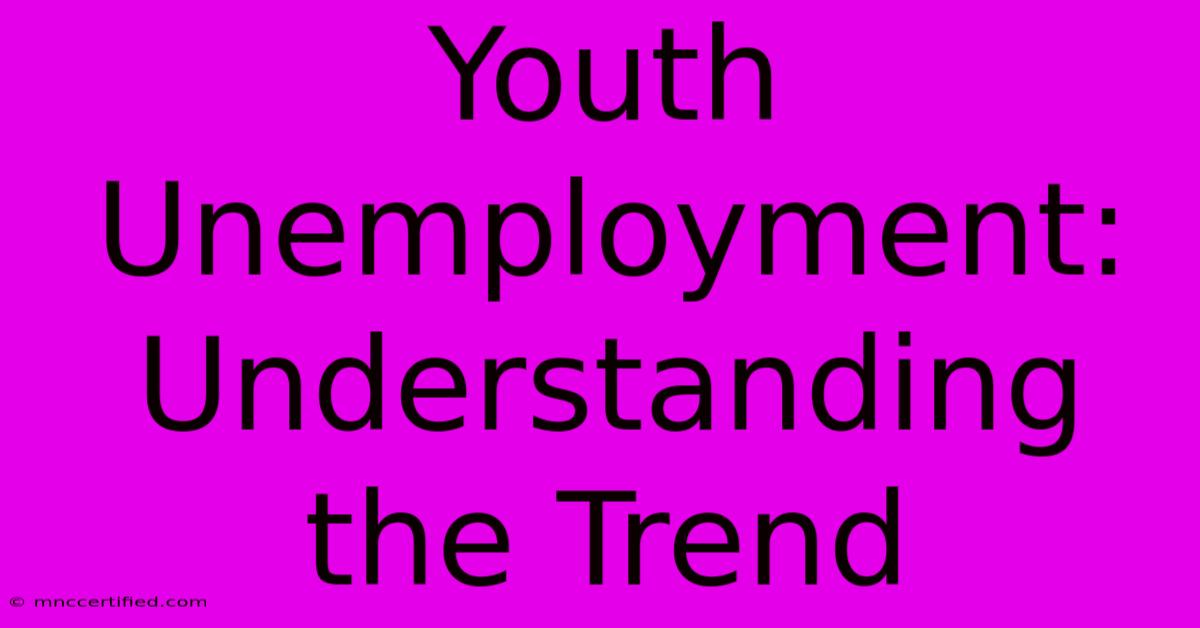Youth Unemployment: Understanding The Trend

Table of Contents
Youth Unemployment: Understanding the Trend
Youth unemployment is a persistent global challenge with far-reaching consequences. This article delves into the underlying causes, significant impacts, and potential solutions to this pressing social and economic issue. We'll explore the complexities of this trend, examining both global statistics and localized factors that contribute to the problem.
Defining the Problem: What is Youth Unemployment?
Youth unemployment, typically defined as unemployment among individuals aged 15-24, represents a disproportionately high rate of joblessness within this demographic compared to the overall adult population. It's a multifaceted issue influenced by a range of economic, social, and educational factors. Understanding this nuanced definition is crucial for effective policymaking and intervention strategies. The International Labour Organization (ILO) provides comprehensive data and analysis on global youth unemployment trends, offering a valuable resource for researchers and policymakers.
Key Differences from Adult Unemployment
While adult unemployment is a serious concern, youth unemployment presents unique characteristics. Young people often lack the experience and established networks necessary for securing stable employment. Furthermore, they may face challenges related to education and training, leaving them ill-equipped for the demands of the modern job market. This disparity necessitates distinct approaches to addressing the problem, focusing on skills development, mentorship, and creating entry-level opportunities.
Understanding the Driving Forces: Causes of Youth Unemployment
Several interconnected factors contribute to the persistently high rates of youth unemployment worldwide. These include:
1. Economic Slowdowns and Recessions:
Economic downturns disproportionately affect young workers, as they are often the first to be laid off or face hiring freezes. A lack of economic growth directly translates to fewer job opportunities, exacerbating youth unemployment. Analyzing historical economic data shows a clear correlation between economic recession and rising youth unemployment rates.
2. Skills Gap and Education Mismatch:
A significant mismatch often exists between the skills possessed by young people and the skills demanded by employers. Educational systems may not adequately prepare young people for the evolving demands of the modern workforce, leading to a skills gap that hinders employment prospects. Investing in vocational training and aligning education curricula with industry needs are crucial steps in addressing this problem.
3. Lack of Experience and Networks:
Young people often lack the professional experience and established networks that can facilitate job searching and career advancement. This makes it harder for them to compete with more experienced candidates. Initiatives promoting internships, apprenticeships, and mentorship programs can help bridge this gap.
4. Discrimination and Bias:
Discrimination based on factors such as gender, race, and ethnicity can significantly impact employment opportunities for young people. Addressing systemic biases and promoting inclusivity within hiring practices is essential for creating a fair and equitable job market.
5. Automation and Technological Advancements:
Rapid technological advancements and automation are transforming the job market, leading to job displacement in certain sectors. This requires proactive measures to reskill and upskill the workforce, preparing young people for the jobs of the future. Investing in STEM education and digital literacy programs is critical in this context.
The Impact of Youth Unemployment: Ripple Effects Across Society
The consequences of high youth unemployment extend far beyond individual hardship. It significantly impacts:
- Economic Growth: A large pool of unemployed young people represents lost productivity and potential economic growth.
- Social Stability: High youth unemployment can lead to social unrest, crime, and increased inequality.
- Future Workforce: A generation burdened by unemployment may struggle to achieve their full potential, impacting future workforce productivity.
Combating Youth Unemployment: Strategies for Effective Intervention
Addressing youth unemployment requires a multi-pronged approach involving governments, businesses, and educational institutions. Key strategies include:
- Investing in Quality Education and Skills Development: Focusing on STEM education, vocational training, and life skills development programs.
- Creating Job Opportunities: Government initiatives to stimulate job growth, particularly in sectors with high youth employment potential.
- Promoting Apprenticeships and Internships: Providing practical work experience and mentorship opportunities.
- Addressing Discrimination and Bias: Implementing policies promoting diversity and inclusion in hiring practices.
- Supporting Entrepreneurship: Encouraging young people to start their own businesses.
- Strengthening Social Safety Nets: Providing unemployment benefits and other support systems for young people.
Conclusion: A Collaborative Effort for a Brighter Future
Youth unemployment is a complex challenge that demands a coordinated and sustained effort from all stakeholders. By implementing evidence-based strategies, investing in education and training, and promoting inclusive job markets, we can create a more equitable and prosperous future for young people and society as a whole. The ongoing dialogue and collaboration between governments, businesses, and educational institutions are essential for tackling this persistent global issue effectively. Continuous monitoring and evaluation of implemented programs are critical to ensure their effectiveness and adapt strategies as needed.

Thank you for visiting our website wich cover about Youth Unemployment: Understanding The Trend. We hope the information provided has been useful to you. Feel free to contact us if you have any questions or need further assistance. See you next time and dont miss to bookmark.
Featured Posts
-
Sixers Defeat Spurs Amid Turnover Issues
Dec 24, 2024
-
House Finds Evidence Gaetz Paid For Sex Frequently
Dec 24, 2024
-
California Wharf Collapses 3 Injured
Dec 24, 2024
-
Congressman Gaetz A Quick Ascent
Dec 24, 2024
-
The Gaetz House Ethics Report
Dec 24, 2024